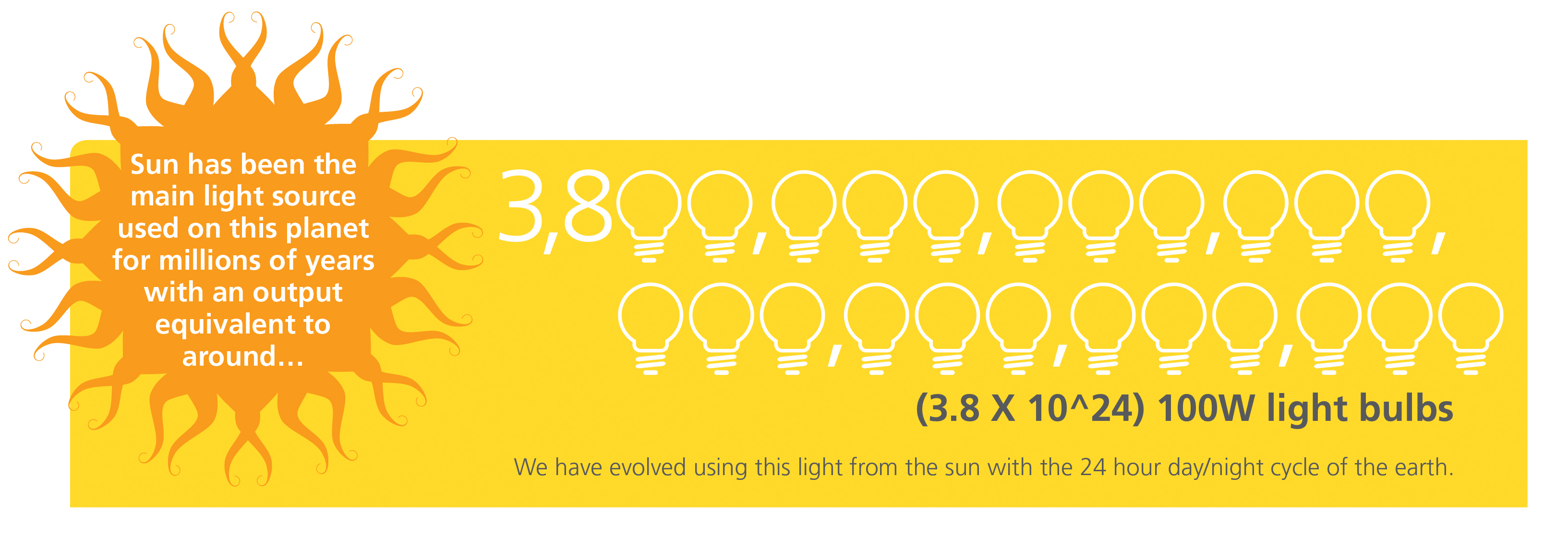Use of lighting to improve health and wellbeing
Lighting affects our health. It affects our mood and circadian rhythms. Poor lighting is linked to glare, headaches, eyestrain, skin conditions and various types of sight loss. So what can building owners and occupants do about it?
1 - Ensure lighting is well maintained. Failed lighting creates dark areas which may be unsafe. Faulty lighting that flashes on and off can cause headaches or epileptic seizures.
2 - Reduce exposure to glare. Arrange visual display units so that reflected glare from luminaires and other brightly-lit areas is limited or avoided. Use matt rather than gloss finishes. Use bright finishes of high reflectance for ceilings and walls to enhance the overall luminance of the space.
3 - Use daylight where possible. Raise blinds when not needed. Create areas with plenty of sunlight and good ventilation so they do not overheat.
4 - Get outside. Exposure to bright daylight and sunlight can help keep the body clock entrained and avoid the symptoms of SAD (Seasonal Affective Disorder).
5 - Be aware of UV exposure. If used for long periods, fluorescent lamps close to the skin, such as desk lamps, should have a protective glass cover, or use LED’s instead.
6 - Reduce shift work, especially night work. Rapid rotation of shifts (a change every few days) is better than weekly rotation as this interferes with circadian rhythms. Use clockwise rotation of shifts (morning, afternoon and night) to ensure adequate rest. Avoid early starts to morning shifts.
7 - Dispose of lamps correctly. Follow Public Health England recommendations for dealing with broken fluorescent lamps to reduce exposure to mercury. Recycle lamps at the end of life by following local lamp recycling instructions.
This article was created by --BRE_Buzz. It was originally published on BRE Buzz in October 2015 and was written by Ali Nicholl, Innovation Network Manager at BRE.
You can see the original article here.
[edit] Related articles on Designing Buildings Wiki
- 7 ways better lighting can improve your health.
- Adequate lighting.
- BRE articles on Designing Buildings Wiki.
- BRE Expert Collection 6 Daylight and shading.
- Building Research Establishment.
- Circadian rhythms.
- Daylight benefits in healthcare buildings
- Daylight lighting systems.
- General lighting v task lighting.
- Health and wellbeing impacts of natural and artificial lighting.
- Human-centric lighting.
- Lighting.
- Lighting and energy efficiency.
- Lighting and health FB 74.
- Lighting and health infographic.
- Lighting designer.
- Lighting for circadian rhythms.
- Site layout planning for daylight and sunlight.
- The impact of lighting in retail design.
- The essential guide to retail lighting.
- Types of lighting.
Featured articles and news
RTPI leader to become new CIOB Chief Executive Officer
Dr Victoria Hills MRTPI, FICE to take over after Caroline Gumble’s departure.
Social and affordable housing, a long term plan for delivery
The “Delivering a Decade of Renewal for Social and Affordable Housing” strategy sets out future path.
A change to adoptive architecture
Effects of global weather warming on architectural detailing, material choice and human interaction.
The proposed publicly owned and backed subsidiary of Homes England, to facilitate new homes.
How big is the problem and what can we do to mitigate the effects?
Overheating guidance and tools for building designers
A number of cool guides to help with the heat.
The UK's Modern Industrial Strategy: A 10 year plan
Previous consultation criticism, current key elements and general support with some persisting reservations.
Building Safety Regulator reforms
New roles, new staff and a new fast track service pave the way for a single construction regulator.
Architectural Technologist CPDs and Communications
CIAT CPD… and how you can do it!
Cooling centres and cool spaces
Managing extreme heat in cities by directing the public to places for heat stress relief and water sources.
Winter gardens: A brief history and warm variations
Extending the season with glass in different forms and terms.
Restoring Great Yarmouth's Winter Gardens
Transforming one of the least sustainable constructions imaginable.
Construction Skills Mission Board launch sector drive
Newly formed government and industry collaboration set strategy for recruiting an additional 100,000 construction workers a year.
New Architects Code comes into effect in September 2025
ARB Architects Code of Conduct and Practice available with ongoing consultation regarding guidance.
Welsh Skills Body (Medr) launches ambitious plan
The new skills body brings together funding and regulation of tertiary education and research for the devolved nation.
Paul Gandy FCIOB announced as next CIOB President
Former Tilbury Douglas CEO takes helm.
UK Infrastructure: A 10 Year Strategy. In brief with reactions
With the National Infrastructure and Service Transformation Authority (NISTA).
























